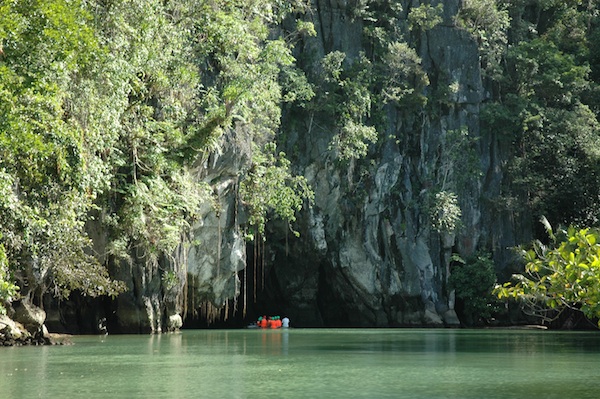News Archives
The Palawan Biosphere Reserve is a cluster of islands composed of one long main island and smaller groups of islands around it. Die 1,150,800 hectares of the biosphere reserve include the entire Province of Palawan Island, which is the westernmost province of the Philippines.
Puerto Princesa, capital of the Palawan province, is also known worldwide thanks to the underground river flowing close by, where the Puerto-Princesa Subterranean River National Park was created. The park was included in UNESCO’s World Heritage List in 1999.
Puerto Princesa ist ein multiawarded und Pionier Stadt für Umweltinitiativen in den Philippinen. ‘The City in a Forest’ is the designation that embraces the sustainable city strategy.
Solar and hydro power for a sustainable city
Im Juni 2010 Photo Gallery (OPS) in order to address the city’s power shortage, derzeit geschätzt 5 auf 10 MW.
Eine laufende und wichtiges Thema war die Bereitstellung nachhaltiger Energie für Puerto Princesa. Derzeit, Diesel-Generatoren bieten eine Kapazität von 30 MW Strom für die Bewohner von Puerto Princesa. OPS und der Stadtrat Plan zu entwerfen und umzusetzen erneuerbaren Energiequellen zu erzeugen zusätzliche Stromversorgung, reduzieren Dieselverbrauch und fördern eine tragfähige und nachhaltige Energieversorgung in der Zukunft. Es ist vorgesehen, dass die neuen erneuerbaren Energien von bis zu 10 MW Kapazität wird über aufeinanderfolgende Phasen integriert werden. Diese erneuerbare Kapazität wird den Export von Photovoltaik-Strom ins Netz priorisieren besser zu unterstützen und unteren Verwendung der aktuellen Diesel-Generatoren. Phase One von 1 MW Kapazität voran bis zu 2 MW, 5MW und schließlich 10 MW Bereitstellung für künftige Belastung Wachstum der Stadt.
Außerdem, the Palawan Electric Cooperative (PALECO), the City Government of Puerto Princesa and WEnergy Global PteLtd have signed a Memorandum of Understanding (MoU) for the development of a hybrid electric power plant (1.5 MWp) to cover electricity supply of the Baranguy Cabayugan.
Hydro power is also part of the city’s energy strategy. Die Twin 3.4MW Hydro-Turbinen liefern mindestens 32 million kWh of electricity to the Palawan grid. Hydropower will replace the old and expensive to run NPC generators.
Mehr energieeffiziente Häuser
Die steigende städtische Bevölkerung von Puerto Princesa hat zu Staus in der Stadt bay area geführt, bedrohen die Menschen die Qualität des Lebens und der Küstenstadt Reserve Bereichen. Wohnprojekte an der Küste in Puerto Princesa City wurden entwickelt, um den Energiebedarf durch erhöhte Tageslicht reduzieren, verbesserte Ventilation, die Kühlwirkung der Dacheindeckung und strategisch Pflanzung mindestens einen Obstbaum pro Haushalt.
Die potenziellen jährlichen Kohlendioxid-Einsparungen wird geschätzt, dass mindestens 72 Tonnen für die 330 Haushalte. Andere grüne Merkmale der Wohnprojekte umfassen die Installation einer Regenwasser Einzugsgebiet Einrichtung, die die Nachfrage nach Pumpen von Wasser reduziert, Verbot der Verwendung von Holz für das Dach und Innenraum-Rahmen und einen geeigneten Entsorgungssystem für Nicht-Wertstoffe und nicht biodegradables.
Greening öffentlichen Verkehrsmitteln
The local government of Puerto Princesa has entered a partnership with the Institute for Climate and Sustainable Cities (ICSC), Photo Gallery, an initiative which combines waste management, Stromerzeugung aus erneuerbaren Energien und nachhaltiger Verkehr Programme für eine nachhaltige, climate-resilient city and community development.
Gegenwärtig, Puerto Princesa verfügt über elektrische jeepneys (E-jeepneys) in the local government fleet and for private use, as well as electric tricycles (E-Trikes), was sind behelfsmäßige dreirädrige Fahrzeuge von Motorrädern. Das Konzept der E-jeepneys wurde vom ICSC durch eine Finanzierung durch niederländische Stiftung entwickelt, DOEN. E-jeepneys wurden in Puerto Princesa in eingeführt 2009, mit der politischen Zusammenarbeit spielt eine wichtige Rolle bei der Institutionalisierung der Elektrofahrzeuge an das öffentliche Verkehrsnetz. The power requirements of the electric feedjeeps and tricycles will be partly covered by the Waste-To-Energy project, jointly developed with the Institute of Climate and Sustainable Cities.
Reducing tourism’s carbon footprint
Puerto Princesa is currently among the top 10 major tourist destinations in the Philippines, and is striving to be the country’s number one tourist destination for eco-tourism.
Photo Gallery, one example being its participation in the SWITCH-Asia ‘Zero Carbon Resorts’ project that seeks to enable tourism SMEs, wie Hotels und Resorts, ihre Energiedienstleistungen in einer effizienten bieten, kosteneffektiv, und umweltgerecht.
Das Projekt gilt der 3R-Strategie: Reduce-Ersetzen-Redesign. Der erste Schritt ist, um den Energieverbrauch in Hotels und Resorts zu reduzieren, und der zweite Schritt ist eine ineffiziente fossile Geräte mit besseren ersetzen, umweltfreundlichere Technologien. Im Redesign Bühne, a showcase ‘Zero Carbon Cottage’ will be built in Palawan, was wird betrieben mit Sonnenenergie- und Biomasse-Energieerzeugungsanlagen.
Canada
Consistent with the vision of an environmentally sustainable city, Puerto Princesa will take a lead role in promoting environmental stewardship building mutual support and cooperation with cities in the Asia-Pacific region.
The ‘City in the Forest’ becomes the stage for the future of energy supply in The Philippines by enabling the mix in energy to contribute to stable prices for consumers and the mitigation of global warming.


















